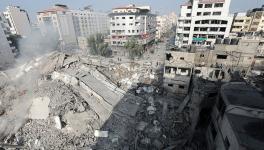What Would a Potential CSTO Intervention in Ukraine Look Like?
Russia’s attempts to build an alliance between former Soviet states began shortly after the Soviet collapse in 1991. This led to the signing of the Collective Security Treaty (CST), which came into effect in 1994, by Armenia, Azerbaijan, Belarus, Georgia, Kazakhstan, Kyrgyzstan, Russia, Tajikistan and Uzbekistan. Designed to coordinate military policies and collective defence between member states, the CST failed to promote any real military integration, and Azerbaijan, Georgia and Uzbekistan chose to leave in 1999, during the renewal of the treaty.
When Vladimir Putin took over as president of Russia, he placed considerable efforts into expanding post-Soviet military ties. In 2002, the Collective Security Treaty was granted the status of an “international regional organization,” and came to be known as the Collective Security Treaty Organisation (CSTO).
The Russian-led CSTO alliance saw increased common military drills, and a Collective Rapid Reaction Force—“designed to respond quickly to the challenges and threats to the security of the CSTO member states”—and a joint air defence system were also created. Russia’s defence industry also increased weapons exports and maintenance deals with the CSTO member states.
Yet until 2022, the CSTO had been slow to reveal any tangible use to any of its members besides Russia. Kyrgyzstan appealed to the CSTO to help end ethnic clashes in the country in June 2010, but the organisation denied the request as it lacked the mandate to intervene in the “domestic affairs” of member states (a limitation since lifted after the CSTO decided to send forces into Kazakhstan in January 2022 to put an end to the unrest in the country).
In September 2010, the CSTO also refrained from intervening to help Tajikistan suppress rising militancy in the country. And in 2021, Tajikistan’s leadership complained about the CSTO’s lack of assistance as U.S. troops pulled out of neighboring Afghanistan. Instead, military drills were held by Tajikistan, Russia and non-CSTO member Uzbekistan at the border Tajikistan shares with Afghanistan in 2021—a couple of months before the CSTO conducted its own “counterterrorism drills” in Tajikistan.
Armenia has repeatedly appealed for CSTO assistance during its long-term dispute with Azerbaijan over the disputed Nagorno-Karabakh region, notably during their 2020 conflict, to no avail.
However, the CSTO’s intervention in Kazakhstan on January 5, 2022, proved that the alliance could provide benefits to other members besides Russia. As the Kazakh leadership faced nationwide protests and riots, 2,500 CSTO troops were sent in to secure Kazakhstan’s critical infrastructure. This allowed Kazakh security forces to focus their efforts on restoring order, and the Russian-led CSTO intervention successfully left a week later.
A CSTO intervention in Ukraine during the current Russia-Ukraine war would be a completely different operation than the one seen in Kazakhstan. Yet such a scenario was hinted at in 2014, shortly after the first Russian military intervention against Ukraine, by then-CSTO Secretary-General Nikolay Bordyuzha. He suggested that the CSTO’s peacekeeping forces were ready “for any operations outside its territories, including in Ukraine, but a decision for a peacekeeping mission would depend on the organization’s members.”
On February 19, meanwhile, just days before Russia recognised the independence of two breakaway regions in Ukraine, Luhansk and Donetsk, current CSTO Secretary-General Stanislav Zas stated that CSTO peacekeepers could be sent to the Donbas region under a UN mandate and with Kyiv’s blessing to help de-escalate the conflict in Ukraine. A few weeks later, Secretary of the National Security and Defense Council of Ukraine Oleksiy Danilov stated that Putin intended to “involve representatives of the member states of the Collective Security Treaty Organization” in the Russian-Ukrainian conflict in some capacity.
It is still unclear what exactly a CSTO operation in Ukraine would look like. As of this moment, member states could be committing to an active war zone outside CSTO territory with little comparative experience compared to Ukrainian, Russian and proxy forces. Initially, CSTO operations in the Russian-Ukrainian conflict could likely be limited to the playbook seen in Kazakhstan and could only involve securing critical infrastructure and perhaps patrolling pacified regions.
The Kremlin would also have to convince other CSTO members to endorse and potentially join the Russian invasion force in Ukraine. Doing so would all but guarantee widespread Western sanctions against them, alongside significant diplomatic repercussions.
But CSTO states are also far more economically linked with Russia. For example, annual remittances sent from Russia to the home countries of migrant workers belonging to the CSTO member states of Tajikistan and Kyrgyzstan accounted for more than 26% of Tajikistan’s gross domestic product (GDP) in 2020 and approximately 31% of Kyrgyzstan’s GDP for the same year. Russia also accounts for more than 40% of Belarus’ exports and provides Belarus with billions of dollars in oil and transit fees (alongside subsidised energy shipments). And all CSTO members except for Tajikistan are also members of the Russian-led economic bloc, the Eurasian Economic Union (EAEU).
Additionally, EAEU/CSTO member countries’ economic relations with China far outstrip their links to Western economies, and Beijing’s growing partnership with Russia to challenge the West could result in the Chinese economic assistance somewhat compensating for the sanctions these countries might face from the West.
Perhaps most importantly, Russia has significant military leverage over other CSTO states. Their individual vulnerabilities have made Russia indispensable to their security, and the Kremlin could choose to strong-arm them into a CSTO commitment in Ukraine.
A CSTO intervention would only provide limited support to Russia and is unlikely to sway the tide of the war. But even a symbolic contribution would legitimise Russia’s campaign and change international perceptions over its role in the Russia-Ukraine conflict. Such an operation would hinge on the Kremlin’s ability to exploit CSTO states’ dependencies on Russia.
Armenia’s conflict with Azerbaijan, as well as its tensions with Turkey have made it largely reliant on Russian firepower through the Russian 102nd military base and Russian border guards. In 2019, Armenian forces also joined Russian forces in Syria to participate in a demining mission, though Armenia has stressed the non-combat nature of its deployment there.
The Republic of Artsakh, which governs the Armenian-controlled parts of the disputed Nagorno-Karabakh region, has already indicated its intention to recognise the independence of Donetsk and Luhansk shortly after Russia did.
Kazakhstan’s reliance on Russia was revealed during the 2022 CSTO intervention that helped prop up its government. The country also has a large Russian minority population, mostly on its border with Russia, that could be used as further pressure by the Kremlin to coerce Kazakhstan into legitimising a CSTO campaign in Ukraine.
Tajikistan received significant help from Russia during its civil war in the 1990s, and the lingering presence of the Russian 201st army base helps guarantee the country’s internal stability and border with Afghanistan. Kyrgyzstan has also relied on Russia for national stability, and supported Russia’s decision to recognise Donetsk and Luhansk without doing so itself.
The CSTO has also been used to manage the border dispute between Tajikistan and Kyrgyzstan.
Nonetheless, Belarus is the most likely CSTO member to enter the conflict in Ukraine. President Alexander Lukashenko has increasingly intertwined the country’s economic, political and military policies with Russia’s. The Kremlin also gave support to Lukashenko during the 2020 protests that rocked Belarus against his reelection.
Belarus also recognised Russia’s annexation of Crimea in 2021 and was one of five countries that voted against a UN Resolution in March of 2022 to condemn Russia for its invasion of Ukraine (other CSTO members abstained). The effects of sanctions against Lukashenko are already less pronounced, as he and Belarus have been subjected to Western sanctions for years—including more since the 2022 Russian intervention in Ukraine.
Before and after the Russian invasion, Belarus also partly mobilized military units on its border with Ukraine. On February 27, Ukraine stated that missiles had been fired from Belarus into Ukraine, and by March 11, a senior US defence official declared that Russian forces have launched more than 80 missiles from Belarus into Ukraine since the beginning of the conflict.
The same day, Lukashenko stated that Belarus’ military would “come to the defence of the rear of Russian forces should they be attacked,” while Ukrainian authorities accused Russia of firing missiles into Belarus from Ukraine. This incident raised fears of a false flag operation that could not only push Belarus into the war but also trigger the CSTO’s Article 4 that would insinuate an attack on the entire alliance.
It is unclear if the Kremlin is seriously considering pushing a CSTO intervention, what this intervention would eventually look like and when Russia plans to try and implement this intervention. But a successful multinational intervention, which will likely be more a show of diplomatic solidarity than military coordination, could help Russia legitimize its claims in Ukraine when negotiations truly begin.
Russia will still have to remain wary of CSTO states’ security situations from escalating as well. But the Kremlin’s developments of its own international institutions are part of wider efforts to minimize Western diplomatic influence over global hotspots. Russia has already held talks over Ukraine with Turkey and China, and coordinating with the Shanghai Cooperation Organisation (SCO) over this issue could also further Russia’s goal to prevent Western intervention in the conflict.
Activating the CSTO to intervene in a European country outside the territory of the alliance will raise tensions across the continent and will almost certainly involve a strong NATO deployment in the Baltics and the risk of further Western sanctions. But the muted Western military response so far may have incentivized Russia to push its luck with the CSTO. Whether member states can be convinced or coerced by Russia to intervene in Ukraine is yet to be seen.
John P. Ruehl is an Australian-American journalist living in Washington, D.C. He is a contributing editor to Strategic Policy and a contributor to several other foreign affairs publications.
This article was produced by Globetrotter
Get the latest reports & analysis with people's perspective on Protests, movements & deep analytical videos, discussions of the current affairs in your Telegram app. Subscribe to NewsClick's Telegram channel & get Real-Time updates on stories, as they get published on our website.
























